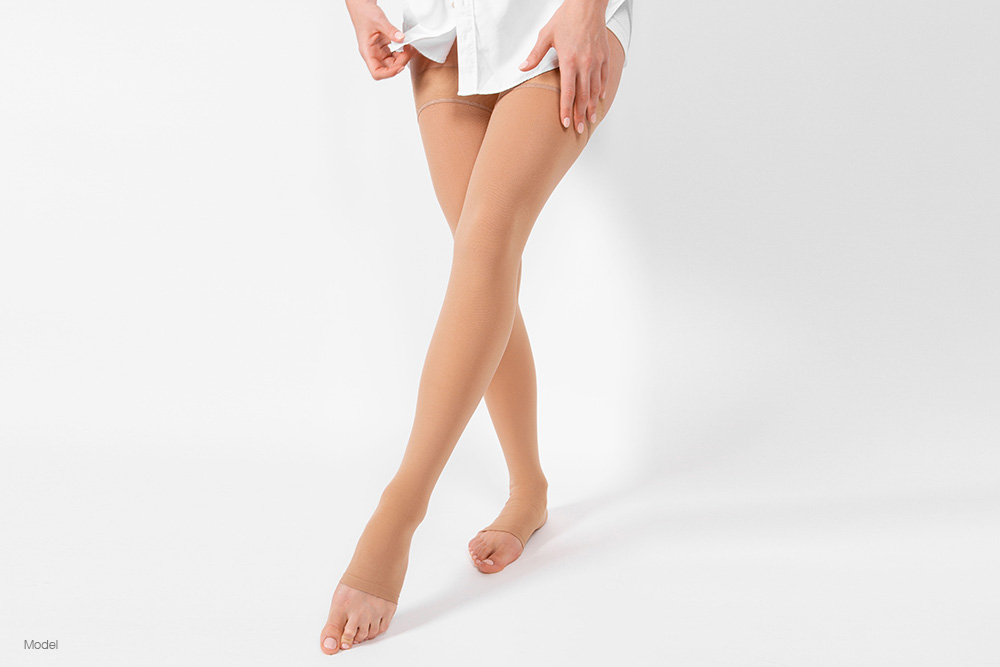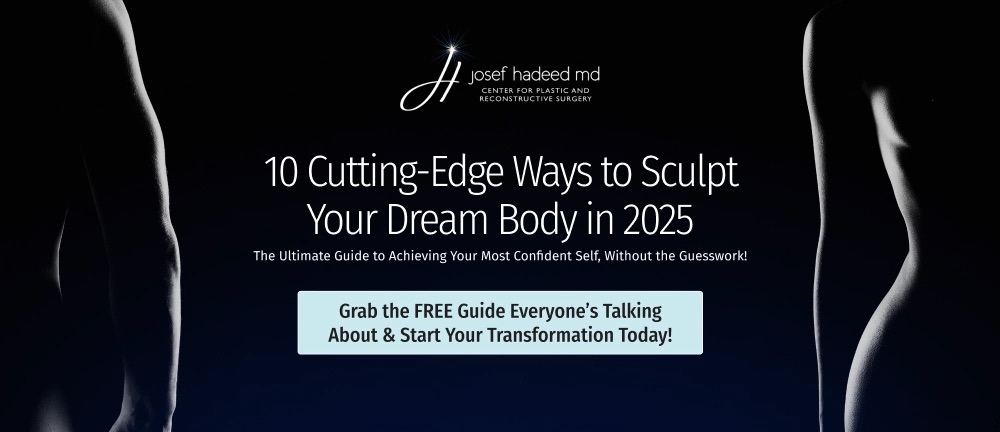How Compression Garments Help Treat Lipedema
Posted October 24, 2025 in Body Procedures by Josef Hadeed, MD

Lipedema is a chronic condition that affects millions of people—primarily women—and is often misunderstood, misdiagnosed, and mistaken for simple weight gain. As a chronic disease, lipedema has a persistent, long-term impact on health and quality of life, requiring ongoing management. If you’ve noticed that your legs or arms seem disproportionately larger than the rest of your body and are often painful or tender, these may be clinical manifestations of lipedema. Fortunately, there are effective ways to manage your symptoms and minimize discomfort. In this blog, we’ll explore what lipedema is and how wearing compression garments plays an essential role in easing your symptoms.
9 Min Read:
What Is Lipedema?
Lipedema is a chronic, progressive condition characterized by an abnormal accumulation of fat on the body, most commonly in the lower extremities, like the legs, thighs, hips, and occasionally the arms. This abnormal accumulation primarily affects the subcutaneous tissue and fat tissue, leading to thickening and irregularity in these layers. Unlike typical fat that can be lost with diet and exercise, lipedema fat is resistant to these methods. It often affects both sides of the body equally and causes a distinct “column-like” appearance of the legs.
One of the most defining symptoms of lipedema is the pain and tenderness experienced in the affected areas. People with lipedema frequently bruise easily and suffer from swelling that worsens throughout the day, as well as a feeling of heaviness or tightness in their limbs. If left untreated, lipedema can interfere with your mobility and even impact your overall quality of life.
What Causes Lipedema?
While the exact cause of lipedema is largely unknown, it’s believed to have a strong hormonal and genetic component. It almost exclusively affects women and often develops or worsens during hormonal changes, such as puberty, pregnancy, or menopause.
It is believed that these hormonal imbalances may affect how the fat in your body is distributed and metabolized, which then leads to the disproportionate buildup of fat cells in certain areas. Changes in body mass index are often observed as lipedema progresses, with higher BMI correlating with increased disease severity. Genetics also plays a significant role, as lipedema often runs in families. Additionally, dysfunction of the lymphatic system may contribute to the abnormal fat and fluid distribution seen in lipedema.
Environmental and lifestyle factors may also contribute to the progression of lipedema, but they are not considered to be the root causes. This is why women with lipedema often struggle to lose fat in the affected areas despite adhering to a healthy diet and exercise routine.
Is Lipedema Preventable?
Unfortunately, lipedema is not preventable, as it is caused by hormonal and genetic factors. However, early diagnosis and diligent management of the condition can slow its progression and reduce your discomfort. Recognizing signs in the early stages of lipedema, especially if you have a family history, can make a big difference in how easily your symptoms can be managed over time.
Identifying lipedema in its early stages allows for more effective pain management and can help prevent the condition from advancing to more severe stages. After early diagnosis, conservative treatment is typically recommended as the initial approach to manage symptoms and improve outcomes.
Lifestyle modifications, such as a healthy, balanced diet, regular exercise, appropriate physical therapy, and avoiding prolonged periods of standing or sitting, can all help minimize lipedema swelling and improve circulation. While these steps cannot prevent or stop the condition from progressing, they can help improve the overall quality of daily life for lipedema patients.
How Do Compression Garments Help Lipedema?
Compression therapy is one of the most effective ways to treat lipedema without surgery. Specially designed garments—such as compression leggings, sleeves, or pantyhose—are worn to apply consistent, gentle pressure to the areas affected by lipedema, which can help reduce edema, manage interstitial fluid, and address excess interstitial fluid, as well as:
Reduce Swelling and Fluid Buildup
Lipedema often causes excess lymphatic fluid to build up in the tissues. This fluid retention can be quite painful for many lipedema patients. Compression garments encourage lymphatic flow and help prevent fluid accumulation, which in turn keeps swelling to a minimum.
Support Pain Relief
Many people with lipedema experience a significant reduction in pain when they wear properly fitted compression garments. The consistent pressure helps relieve tenderness and limb heaviness by improving the circulation of blood and lymph fluids.
Improve Mobility and Comfort
By reducing swelling and supporting tender tissues, compression garments can make walking, exercising, and performing your routine daily activities easier and more comfortable.
Prevent Disease Progression
Consistent use of compression garments can help limit further accumulation of fat and fluid buildup, which can alleviate discomfort and slow the progression of your lipedema. Physical therapy, compression treatment, and other conservative treatments taken during the early stages can slow down the development of severe lipedema.
Enhance Your Surgical Results
If you undergo lipedema surgery, compression garments are an essential part of your recovery. They help shape your results, minimize post-surgical swelling, and support your healing tissues.
When it comes to compression garments, success depends on whether they fit correctly and whether you wear them consistently. Selecting the right compression class and type of medical compression is important to ensure optimal results and comfort. Lipedema patients should also be instructed on how to wear compression garments properly to maintain adherence and avoid discomfort. Compression garments that are too loose won’t provide the necessary pressure, while those that are too tight may restrict blood flow. You may wish to purchase custom-fitted compression garments to reap the maximum therapeutic benefits.
Types of Compression Products
Managing lipedema symptoms often requires a personalized approach, and there is a wide range of compression products designed to meet the unique needs of each individual. These products play a crucial role in compression therapy, helping to improve lymphatic flow, reduce fluid accumulation, and alleviate discomfort in the affected limbs. Understanding the different types of compression garments and devices can empower lipedema patients to make informed choices that enhance their quality of life.
Compression stockings are among the most widely used options, especially for those experiencing lipedema in the lower extremities. Available in knee-high, thigh-high, and full-length styles, these stockings deliver graduated compression—strongest at the ankle and gradually decreasing up the leg—to minimize edema, support lymphatic flow, and reduce pain throughout the day.
For those with lipedema symptoms in the arms, compression sleeves offer targeted support. By applying gentle, consistent pressure, these sleeves help manage swelling and promote healthy circulation in the upper limbs.
By incorporating the appropriate compression products into their daily routine, men and women with lipedema can experience significant relief from swelling, improved mobility, and a better overall quality of life. With the right support, managing lipedema becomes more achievable, allowing patients to stay active and comfortable throughout their journey.
Are There Other Non-Surgical Lipedema Treatments?
While compression treatment is an excellent option for addressing lipedema without surgery, a comprehensive approach to treatment often includes several other non-surgical options to manage your lipedema symptoms and improve your overall comfort. These may include:
- Manual lymphatic drainage (MLD), which is a gentle, specialized massage technique used to stimulate lymph flow and reduce swelling. MLD can also decrease pain by influencing nerve fibers involved in pain perception and improving the function of lymphatic vessels.
- Pneumatic compression devices, which are inflatable sleeves that provide dynamic compression by utilizing controlled air pressure cycles to further encourage lymphatic drainage. These devices help stimulate lymphatic vessels and promote the movement of excess fluid from tissues.
- An anti-inflammatory diet, focused on reducing sodium and processed foods, and increasing your consumption of whole, nutrient-rich foods, to help minimize inflammation and fluid retention.
- Engaging in regular, low-impact workouts can promote healthy circulation and lymphatic flow without placing excessive pressure on your joints.
- Laser or photobiomodulation therapy, which are light-based therapies designed to boost circulation and speed healing.
When used together as instructed by your surgeon, these non-surgical lipedema treatments can significantly alleviate symptoms and help you get the best possible results after lipedema surgery.
How Dr. Hadeed Surgically Treats Lipedema
If your lipedema symptoms persist despite conservative or non-surgical treatments, Dr. Josef Hadeed offers advanced lipedema liposuction surgery to remove the diseased fatty tissue and restore your natural body contours. Surgical treatment is considered for selected cases of lipedema, especially when conservative therapies are insufficient or when specific conditions are present.
Using specialized lymph-sparing liposuction techniques, Dr. Hadeed carefully targets lipedema fat while preserving your lymphatic structures (to avoid complications like secondary lymphedema) and minimizing trauma to the surrounding areas.
This meticulous approach to treating lipedema not only improves your body’s proportions but also alleviates pain, swelling, and limb heaviness. Many patients experience easier mobility and increased self-confidence after surgery, as well as welcome relief from years of discomfort.
Dr. Hadeed’s lipedema treatment protocols typically combine surgery with postoperative compression therapy, lymphatic drainage, and photobiomodulation to accelerate your recovery and support the long-term results of your lipedema liposuction. His goal is to help his patients enjoy both improved health and renewed confidence in their bodies after struggling with the limitations of lipedema.
Explore Lipedema Treatment Options in Beverly Hills
Compression garments are one of the most effective ways to manage lipedema without surgery. While compression therapy won’t cure lipedema, it plays a vital role in controlling the associated swelling, relieving discomfort, and preserving your mobility. However, the gold standard for treating lipedema is specialized liposuction surgery performed by a skilled expert like Dr. Josef Hadeed. To learn more about lipedema surgery and find out if you’re a candidate for the procedure, call our office today at (310) 970-2940 or request an appointment online.

